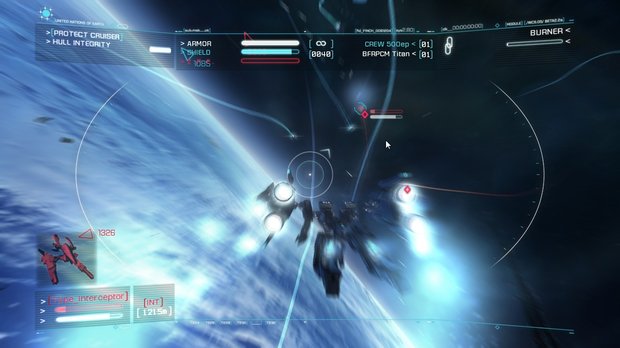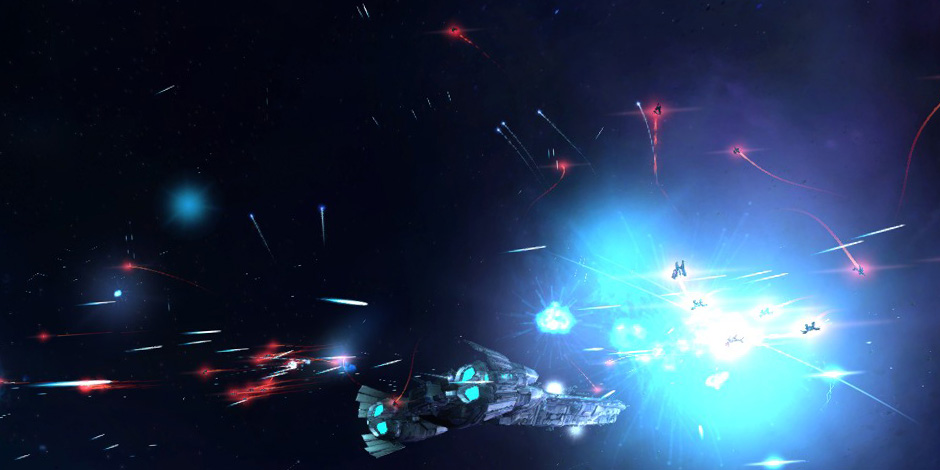GamesRadar+ Verdict
Pros
- +
Its blend of Eastern and Western influences
- +
Piloting the Strike Suit
- +
Rich soundtrack and ambience
Cons
- -
Monotonous shooting and flying
- -
Fleeing battles to replenish health
- -
Dragged-out missions
Why you can trust GamesRadar+
From shooting down TIE Fighters to dogfighting with anthropomorphic animals, space combat games have given players plenty of ways to experience the dead of space. The genre isn’t as prolific as it was during its '90s heyday, but some developers are trying to rescue it before it completely falls off the map. Strike Suit Zero is the latest of these crusades and pays homage to the heavy hitters’ of the genre. It may not be a groundbreaking display of ingenuity, but SSZ captures the scale and volatility of this genre all the same.
SSZ places you in the cockpit of a fighter pilot for the United Nations of Earth (UNE) during an impending attack on the planet. The plot itself is told through the game’s 13 missions, which include summaries, briefings, and in-game transmissions informing you of the UNE’s progress and directives. Not only does this make you feel like the story is unfolding in real-time, but your teammates will be directly engaging you in conversation and yelling out orders making you feel like you’re part of the action.
Missions are divided into primary and secondary objectives for you to complete. More often than not, these objectives involve shooting down specific targets or ensuring your allied ships survive an ambush until you reach a checkpoint. Destroying enemies and defending your allies are the bulk of what you’ll be doing in the game, and SSZ’s biggest problem is its lack of variety. Whether it’s bombing a heavily armored cruiser with your torpedo ship or quickly destroying an enemy’s communication system aboard your stealthiest fighter, the only change you’ll experience is in your environments. You can unlock more guns and ship upgrades as you achieve better scores in each mission, but this customization does little to change up the dynamic of the missions themselves.
"...customization does little to change up the dynamic of the missions themselves."
Secondary objectives don’t have to be finished to continue on with a mission, but ignoring them can not only hurt your chances of achieving a high score, but some can also negatively impact the game’s mutable story. If you let one of your UNE ships get destroyed in one particular instance, for example, you’ll never see it again unless you replay the mission and save it from destruction. These secondary objectives add a welcome layer of challenge and difficulty to the game and test your skills at multitasking. Not only will your hard work pay off in the form of upgrades and leaderboard rankings, but you’ll also be rewarded with various different endings.
SSZ also boasts an impressive scale that truly captures the feeling of being out in space. You’ll often find yourself circumnavigating giant frigates looking for turrets to shoot down or engaging in wide-open dogfights with the enemy. The scale adds to a great experience--if you manage to hit your targets, that is. The sheer size of the maps can make missions drag on longer than they should. Some objectives require you to shoot down a large number of ships, making it a hassle chasing them all down. And if you happen to die, you’ll need to restart everything from the last checkpoint regardless of your progress. Retracing open expanses isn't very fun after a few continues.
The more enjoyable missions take place aboard the Strike Suit, a transforming ship that lets you glide through space with ease. Though controls for your other ships are fluid and responsive, piloting a Strike Suit gives you so much more freedom to fly around space in all directions that you’ll wish all missions let you use it. You still have only guns and missiles to play with, but Strike mode makes it easier to auto-target your enemies and pummel them with an endless supply of missiles. Though it may feel slightly overpowered, Strike mode only lasts as long as your energy meter is full so you’ll need to destroy more enemies to stay transformed. This ship also adds a layer of strategy to some missions, letting you decide when to enter Strike mode or when to wait until the time is right.

"The more enjoyable missions take place aboard the Strike Suit, a transforming ship that lets you glide through space with ease."
Despite being set in the cold reaches of space, SSZ features diverse environments offering a rich blend of warm colors and swirls. Some backdrops resemble giant paintings, and the game’s calming soundtrack gives it a sense of elegance amid all the shooting and killing. This overall ambience is further heightened when you first pilot your Strike Suit and hear singer Kokia’s Japanese vocals offering a reminder of the game’s tactful fusion of Western and Eastern influences.
Even though it borrows heavily from past games, SSZ tries to be more than just a rehashing of an old genre. Its inclusion of a multiple-objective system adds difficulty and depth to its missions, even if they do get repetitive and tiresome at times. Piloting the Strike Suit, however, is the highlight of the game and the reason why you'll want to play it. It may not be very innovative, but SSZ offers plenty of challenge and fun that make it worth revisiting the space combat genre.
More info
| Genre | Action |
| Description | An upcoming space-action arcade game set in the final hours of Earth, in which players must make snap decisions, choose targets on instinct and fight vigorously before time runs out and Earth is destroyed. |
| Platform | "Xbox One","PC","PS4" |
| US censor rating | "Teen","Teen","Teen" |
| UK censor rating | "","","" |
| Release date | 1 January 1970 (US), 1 January 1970 (UK) |



